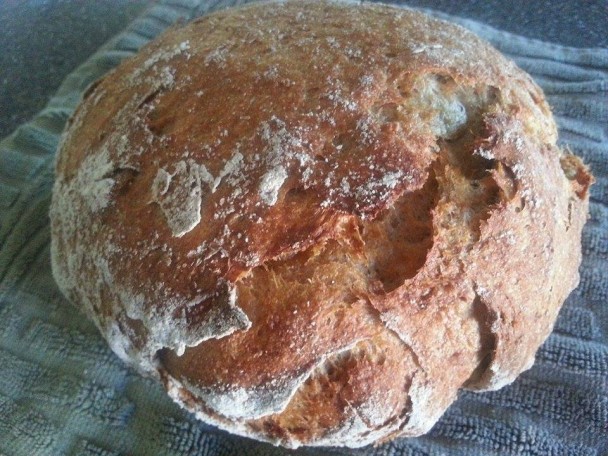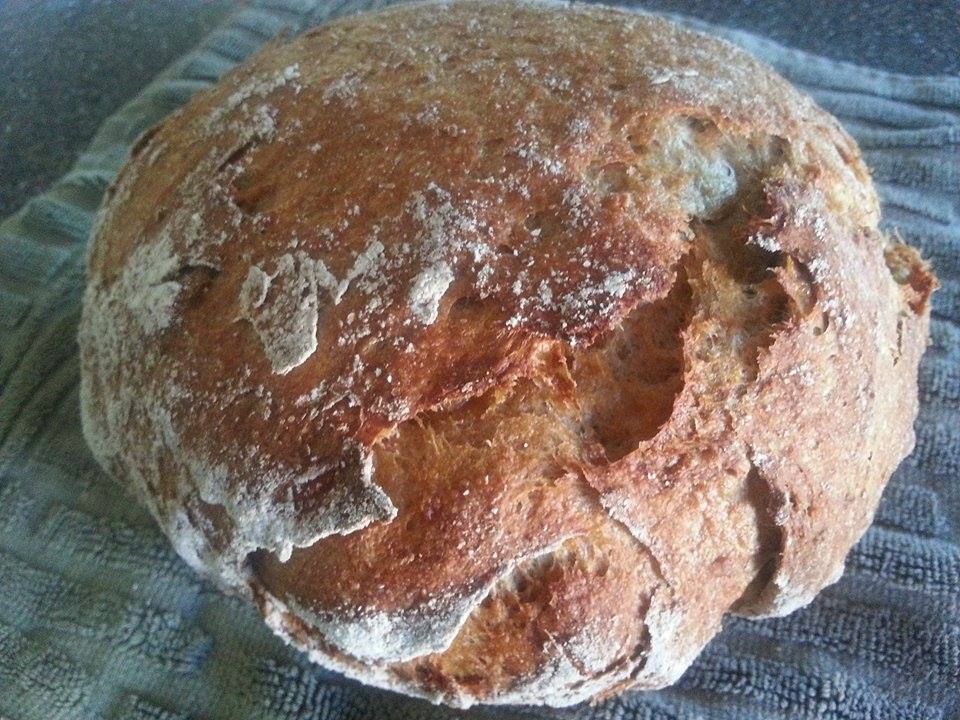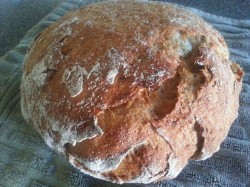Super easy artisan bread with a delicious, golden crust.
Servings
Ingredients
- 5 cups Einkorn Flour
- 1/3 cup Powdered Milk
- 1/2 teaspoon Sea Salt
- 1/2 teaspoon yeast
- 1 3/4 cups Warm Water
Directions

Go here, for a deeper explanation on this recipe.
1. Proof your yeast in the warm water.
2. Sift flour, salt, and powdered milk together.
3. Add the water to your dry ingredients and mix with a spatula. The dough will be fairly sticky.
4. Scrape the sides of your bowl down to incorporate then coverwith plastic wrap.
5. Let it rise for 14 hours in a dark place. The slow rise develops volume and flavor at the same time.
6. After 14 hours preheat your oven to 500 with the dutch oven AND lid in the middle of your oven.
7. Turn your dough out onto a floured surface. Don’t work the dough too much. I fold each side of the dough inward like an envelope to create some more pockets of air.
8. Once your oven is preheated, place your loaf into the dutch oven, place the lid on it and close your oven. Do this as quick as possible so you do not lose your heat.
9. Bake for 35 minutes, take the lid off and bake for another 5-10 minutes.
10. Cool on a rack until completely cool.
11. Enjoy!



Do you think that I can use buttermilk powder?
Hi Susan, I haven’t tried it. It could very well work. If you do try it, we’d love to hear how it goes.
Hi, I’m a novice at this and only have quick rise yeast. Does that make a difference in how long you let it rise? Thank you.
Hi Jolynn, it shouldn’t make much of a difference.
Tried the artisan bread. Do you hav to sift the flour. mine cooked for the 35 minutes and an instant read thermometer came out at 135. Doughy in middle like it needed more cooking time. Followed recipe but wasn’t sticky or watery almost like there was to much flour. Do you sift before measuring or after. Love einkorn whole grain. Want to use with more recipes.
Hi Jannette, the woman who created this recipe doesn’t work for us anymore, so I honestly couldn’t tell you if she intended you to sift the flour or not. I would always recommend judging consistency instead of only worrying about the written amounts. If you feel that less flour would be best, go with your gut!
My experience with einkorn bread results in a much darker loaf. I grind the einkorn myself and so far my loaves are much darker and denser.
Hi Charlie, this recipe most likely was made with all-purpose einkorn flour which results in a much lighter color.
I am excited about finding this site. I have used Eikorn flour a little, but know I should use it all the time.
can you give me a smaller version, instead of 5 cups of flour do you have a recipe for maybe 2 or 3 cups to try?
Hi Judy, you can just cut this recipe in half if you only want to use that much flour.
Ant easy recipe to use it for tortillas ( then i can use it as a burrito ,or wrap
I just made this bread today and am not sure if I’m completely satisfied with the result. The bread came out rather dense. Do you have any tip as to how to make more airy and lighter bread? I let my dough rise for 15 hours. I wonder if I should have let it rise longer and in a warmer place?
Hi Eiko, I am sorry that the recipe didn’t quite do it for you. This recipe was created by a woman who worked for einkorn.com a long time ago but she hasn’t worked here for some time. Since I am not the creator of the recipe, I have a hard time saying how to change it to make it lighter, but I do know that customers have had success with it, so I wouldn’t give up all together. Frequently, artisan breads tend to be a little denser than sandwich breads, but maybe yours was even denser than that, I don’t know. If you’re looking for a sandwich bread type of recipe you can look at our sourdough or yeast bread recipes. If you’re wanting to keep trying with the artisan bread, I would suggest letting the dough be a little wetter. Einkorn tends to be sticky so we run the risk of adding too much flour to combat that. Too much flour will lead to very dense bread. I hope that helps.
Our oven only goes reliably to 450. Will extending the cooking time a bit work?
Alan, we have not tried that. It would probably work just fine. The crust may turn out slightly different but most likely not drastically. If you try it, let us know how it turns out in case anyone else has a similar question.
Do you have sourdough recipes?
We do have a few sourdough recipes. We have muffins, bread, and crackers.The bread recipe can be used for more things like bread sticks, pizza dough, pitas, flat bread etc.
Any tips on how to adapt this recipe using an einkorn sourdough starter would be appreciated!
Jim, I have not done this recipe with a sourdough start, but, if I were going to try it, I would omit the yeast, reduce the water to 1 1/2 cups, and use about 1/2 cup of sourdough start. I would also allow the dough to double in size in a bowl and then punch it down and create the loaf and let it rise again. You may have to do a little experimenting but those are the general guidelines I would suggest.
Can I bake this in a calphalon soup pot I have that is non-stick?
I don’t used powder milk etc, can I use regular milk, or sour cream, more flour, Or What?
Thanks..
Cal, only a cast iron or ceramic pot with a ceramic lid work. They are the only kinds that disperse the heat properly. Otherwise you will need to just do the whole steam thing we talked about with the previous comment from February 5th. Powdered milk just softens the bread. You can just leave it out. If you add milk, it will throw off the moisture in the bread and make it too wet.
Do you grease the Dutch oven before putting in the einkorn bread dough? Thank you. I am anxious to try the recipe.
Yes, good point. you should grease it.
When? Before you put the pot and lid in the screaming hot oven or after?
Hi Lauri, I’d do it after.
Just put the dough on a large piece of parchment paper and lower it into the Dutch oven and put the lid on. The dough won’t stick and it is much easier to pull out the finished bread.
I had read that parchment paper works well. Will it withstand the high heat.
Just my $.02 worth: I don’t like burning greasy substances to my beautiful Le Creuset Dutch ovens! I just breaks my heart! So, instead, I take a piece of parchment paper large enough to wrap around the loaf and up the sides of the Dutch oven. Wad up and un-wad the parchment paper several times (like 3) and it will be much more malleable and shape-able and you will be able to drop the raw loaf sitting on the crinkled up parchment paper into the Dutch oven without branding your hands on the super hot Dutch oven — don’t ask me how I know this. The bread never sticks to the Dutch oven, the Dutch oven stays clean, and the parchment makes a nice sling you can use to withdraw your bread from the Dutch oven — again — without branding your hands. Parchment is yet another thing you’d have to buy, yes, but the results are excellent!
Can you bake this bread recipe in a roasting pan? Or other ideas? I don’t have a dutch oven yet.
Katie, I was wondering the exact same thing. Wondered if I could use a roasting pan with foil sealing in the top.
Katie and Kelly, The purpose of the dutch oven is to create steam inside the pot, rising the loaf and creating a hard crust on the outside. If you don’t desire that, you can just cook it on a cookie sheet. If you do want it, you can put it on a cookie sheet and then put another cookie sheet on the rack beneath it. But you have to put it in the cold oven on the bottom rack and preheat the pan while the oven preheats. Then, put the loaf in the oven on a cookie sheet on the middle rack and pour boiling water in the bottom pan and quickly shut the oven. This will create the steam.
I made this bread with the following changes: used instant yeast, 1 tsp. salt. I let is rise several hours longer and it looked fine, maybe double in bulk. I baked it in my Miele Combi-Steam Oven using the Spelt bread setting. Because it is a steam oven, I did not use a dutch oven and cooked it uncovered in a corningware casserole.
The bread had a beautiful color and smelled great however it was very dense. I’m wondering if I should have proofed the dough before baking so it would have been lighter. Also, it tasted rather bland. If I make it again, I will use 2 tsp. salt.
What are your thoughts on this?
Try adding one tablespoon of rice vinegar to the liquid and substitute half a cup of room temperature stout beer for some of the water. You can eliminate the dry milk powder too. I think 11 or 12 once’s of total liquid is enough. The dough will be a bit shaggier, but if you let it rise for 18 hours or so, then knead it a bit and let rise a second time, about 3-4 hours, or until doubled it will be less dense. I think the addition of the beer and vinegar will also improve the flavor substantially.
I tried this recipe today for the first time. I am not a “baker” and haven’t made bread since the last time 35 years ago with my mom. The dough was very, very sticky (as expected). So much so that it was impossible to work with when I pulled it out of the bowl after rising. There just wasn’t any way to get it off of my hands, let alone into the dutch oven. Obviously, I used too much water, but I followed the recipe exactly. What could I be doing wrong?
That recipe has too much water. I find that with 5 cups of whole grain Einkorn flour all you need is about 1.5 cups water. You know if you put too much water in your recipe, if the loaf falls in the middle when you take it out of the oven. Next time you make the bread, reduce the water a little more.
Reduce the water a bit And it won’t be quite as sticky, then place the proofed loaf on a sheet of parchment paper before putting it in the Dutch oven. This also helps when removing the bread after baking.
Do you score top of loaf or not thanks can’t wait to make this looks beautiful
I made this lovely recipe and did score the top in an X, then moved it to a greased (I used ghee to grease) dutch oven…turned out just like the picture 🙂
Yeasts do not require sugar to feed; they will feed on the simple starches in the flour. The purpose of adding sugar was originally to ‘proof’ or prove that the yeast was still alive and functional – most often for dried yeast products.
I notice that there is no sugar in this recipe, is this correct or a typo.
Doesn’t the yeast need sugar to feed on?
The milk in this recipe is used to “feed” the yeast as well as does the flour.
What can I substitute dry milk powder with?
Can emmer flour be used as well as einkorn flour and what is the difference?
Any alternatives to milk powder? My son can’t eat dairy.
Thanks for the great recipe.
My family doesn’t tolerate milk so we’ve found a number of shortcuts. For 1/3 cup of powdered milk, I would substitute 1 cup of liquid milk substitute like rice, oat or almond milk, and then reduce the amount of water by more than one cup. In other words, I would use 1 cup alternative milk and 1/2 cup water, and add a bit more water if needed. You can also buy powdered soy milk at any natural foods store, and there’s a potato-based powdered milk substitute called darifree that works for people who don’t tolerate soy, rice or nuts.
Keep in mind that the purpose of adding milk to a recipe is to add a bit of flavor and sweetness without adding sugar. You can always experiment by adding a spoonful of honey or other sweetener, but again, you might need to reduce the water or increase the flour slightly because you are reducing the proportion of dry ingredients when you remove the milk powder.
We use powdered goat milk because of dairy intolerance. It is easy to find in any health food store and most Walmarts.
If your son cannot tolerate dairy products, you can either leave the dry milk powder out and add 1T sugar (or honey) or add a powdered whey milk (has none of the lactose most people are sensitive or allergic to).
I would just omit the milk. In Bread 5 Minutes a day recipe there is no milk.
Pingback: Slow Rise Einkorn Bread » Einkorn.com